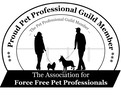Restrict your dog's access around the house until boundaries are established. Avoid encouraging your dog to lie on furniture or go into the bedrooms. If this is behaviour you wish to allow once the relationship is established, ensure that you invite the dog onto/into your resting places and that he/she will move immediately if requested.
If you find it difficult to limit your dog's access around the home and to resting places, attach a lead to his/her collar so that you can gently move the dog and praise the correct response. To avoid the potential of the lead getting tangled on furniture, only attach it when somebody is with the dog.
It is also important that your dog has a safe place to rest comfortably. Ensure that he/she does not become possessive about the bed or the area around it. Make a point of moving the bed and standing briefly in the area, shake up the blanket etc. Avoid placing the dog’s bones and chew toys in the bed when you tidy up as this can give the wrong impression. If he/she leaves 'possessions' into the bed, move them out when the dog is occupied elsewhere. Children should not be allowed to approach or disturb the dog when he/she is in the resting in bed.
Indoor kennels (folding wire pens) can provide a safe and chew-free environment for your dog when you cannot keep an eye on him/her. It is important that the dog sees the indoor kennel as a nice place to be and not somewhere he/she is put when you are angry.
Place the dog’s bed in the pen and feed some of his/her meals in there. When your dog has been active and is becoming tired, encourage him into the kennel with a stuffed Kong or chew toy but leave the door ajar. When the dog is happy to go into the kennel you can begin to close the door to confine him/her for short periods.
While it is reasonable to expect a dog to sleep through the night in an indoor kennel, it is not appropriate to confine him/her in such a small space for long periods during the day. In order to be a fit, happy, confident dog, he/she needs freedom to play and develop physically, explore his/her environment (under supervision) and interact with people. Remember not to leave 'possessions' in the indoor kennel; move the bedding around, remove food dishes and chew toys when the dog is let out.
Ensure that your dog does not always have free access to you when you are at home. There may be times in the dog’s life when he/she cannot be with you, even though you can be heard talking or moving around the house so it is only fair to teach him/her how to accept this calmly from an early stage. Dogs can become very distressed if solitude is suddenly thrust upon them, e.g. if home circumstances change. This distress can lead to barking or howling, chewing and sometimes a breakdown of toilet training.
If somebody is at home most of the time, discourage the dog from following you constantly as you move around the house. It is lovely to have his/her company but if the dog cannot cope for a few minutes while you pop out of the room, being left while you go out will be very distressing.
When you intend to leave the dog on his/her own be quite cool with him/her for a short time before you go. If he/she has just been cuddled and fussed, distress at being left alone will increase. Leave a radio on low and a blanket or jumper, which bears your scent, as comforters.
The dog should be left in a safe, secure area with something really tasty for occupation. A Kong toy stuffed with extra favourite treats is ideal for this purpose. Keeping a special one which is only given to the dog when you are out and picked up when you return home can help to make being left alone more rewarding and less stressful.
__________________________________________________________



 Proprietor of Paws'n'Learn TTouch Guild APDT UK 130 Pet Professionals Guild
Proprietor of Paws'n'Learn TTouch Guild APDT UK 130 Pet Professionals Guild
